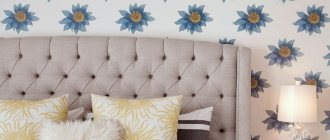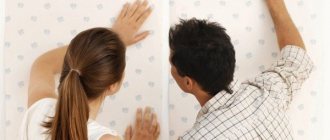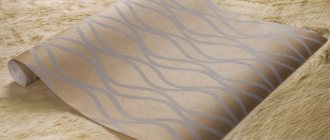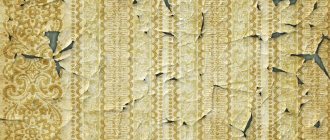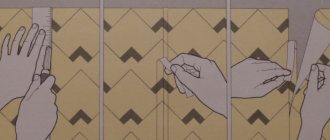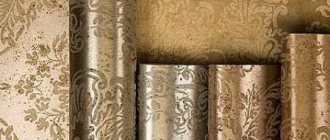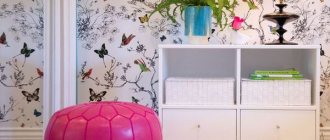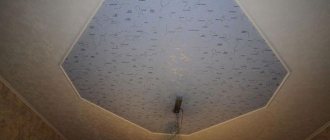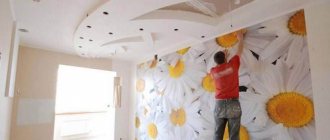Over the past decades, wallpaper has become a truly popular material. They not only do not go out of fashion, but also expand their presence in the market. This happens, not least, thanks to new products that owe their appearance to the use of the latest technologies in production, as well as an innovative approach to design. Among the most interesting and popular new products among mass buyers are foam wallpaper.
Foam wallpapers have different structures and different bases
Vinyl, paper, non-woven backing and profile - depending on the base raw materials used, as well as production technology, they can be completely different.
Foam wallpapers owe their popularity to the fact that they have a significant number of advantages and disadvantages that make them easier to hang and make their service life longer than many other analogues. Thanks to their attractive appearance, they can significantly decorate the interior of your apartment, making it not only practical, but also individual.
Looks soft and textured
In addition, such canvases will look very organic in a non-residential space, such as an office, cafe or administrative building.
Foam paper wallpaper: characteristics
So, what is paper-based foam wallpaper? As the name suggests, they are made on a backing made of paper. Thus, they have two layers - outer and inner.
Foam wallpaper
These canvases are produced using the screen printing method. Here's how it works. Heating occurs inside the oven, reaching a high temperature. This, in turn, starts the process of evaporation of special substances that are part of the composition of the vinyl layer.
Give the home a mysterious look
Accordingly, small cavities, also known as pores, are formed inside. It turns out that due to their formation, the vinyl layer becomes “foamed”.
Helpful information! Due to the fact that the vinyl layer (PVC) has an increased density, it resists the evaporation of atmospheric moisture. This has a positive effect on the characteristics of the canvases, since they prevent the formation and spread of mold and mildew.
Profile foam wallpaper
Related article: Find out how to calculate the length of a curtain rod
In addition, such canvases are also known as “foam profile wallpaper”. As for their surface, it is quite soft and pleasant to the touch.
Here is what is typical for this surface:
- Being slightly rough, it may have a clearly defined relief or pattern.
- Perfectly hides minor damage, chips and scratches on the working surface of the room walls.
- It is characterized by a wide variety of colors and shades, which has a positive effect on the possibilities of designing interior design in various styles.
- Such a voluminous texture of the wallpaper can create the feeling of using attractive relief plaster to decorate the walls of the room.
What it is?
Cloths for finishing walls are presented with a dense base and a light porous decorative coating. The latter is made of modified PVC. Foamed vinyl wallpaper is characterized precisely by its outer layer.
The decision to purchase such material is often accompanied by doubts due to the likelihood of the pattern peeling off. But this phenomenon is excluded, since according to technology the polyvinyl chloride composition is applied by screen printing. The process is accompanied by exposure of PVC to high temperature. As a result, the material is securely bonded to the base and foams.
Pros and cons of paper-based foam wallpaper
All those who are planning to buy similar products for their own apartment would like to learn more about its main advantages and disadvantages. So here they are:
- Increased service life and durability.
- Environmental safety (despite the assertion of some “experts” that such materials are harmful to human health).
- Excellent water resistance, thanks to which they can be wet cleaned.
Foam paper wallpaper
In some cases, when preliminary preparing the surface of the walls, you may not even need to use a finishing layer of putty, since, thanks to the large thickness and textured surface, foamed vinyl wallpaper can do an excellent job of “correcting” all sorts of wall imperfections.
Non-woven foam wallpaper
Of course, it is worth understanding that we are talking exclusively about minor defects, chips and potholes.
It should be recognized that these canvases have a number of disadvantages:
- Due to their soft structure, they are quite susceptible to careless handling and exposure to foreign objects, as a result of which their decorative layer can be damaged.
- Gluing foam vinyl wallpaper on a paper base with your own hands is also not as easy as it might seem. To do this, it is advisable to get an assistant, since it is advisable to carry out all the work on gluing them together.
How to glue
By the way, let's briefly look at the features of properly gluing this wallpaper. As already mentioned, they are able to hide small potholes and imperfections. However, what if you already have old canvases glued up? Or what to do if the wall is painted? In such cases, you will have to completely prepare the walls. If necessary, the walls of the room will need to be puttied, processed with sandpaper, and then completely primed.
Related article: Kitchen window design: choosing curtains, decorating the window sill
After this, you can proceed to gluing. The stages of this work are standard and are no different from gluing any other heavy canvases. As a recommendation, I would like to note that it is very advisable to use specialized types of glue.
Attention! Unlike softer and thinner paper counterparts, after applying a layer of glue, foam wallpaper cannot be folded in half for greater and better impregnation, as this can damage the decorative coating.
As for the interior design of the room, you can use canvases not only of one standard color, but also turn to original design approaches by combining different shades in the interior. Bold color combinations like these, coupled with the above-mentioned benefits, make foam wallpaper an excellent option for almost any room in the apartment. They can be glued in the kitchen, in the hallway (corridor), in the hall (living room), and even in the bedroom and children's room.
Varieties
Like every series of decorative materials, vinyl ones with a foamed structure come to the trading floors in an assortment not only with a difference in design. Here the basic selection criterion is the nature of the substrate or the type of surface.
Based on base material
The base for foam decor can be classic paper or non-woven fabric (synthetic fibers are added to cellulose). The first option is otherwise called foam wallpaper. If we compare both types of canvases, the first will be cheaper, and the second will be stronger and more resistant to moisture.
During dismantling work, panels are often removed layer by layer due to the difficulty of soaking the top layer. There are two solutions to the problem: either remove the polymer coating first, or score the trim to allow water to penetrate through the vinyl.
By degree of readiness
This implies a choice between a finished finishing material and a material that can be painted repeatedly. The latter must be pre-primed.
If the rough base is fragile, then you should choose water-based paints (for example, acrylic). For strong walls, you can use thicker compounds (latex). The difference lies in the severity, drying time and density of the film formed. In any case, only water-soluble paints and varnishes are acceptable.
Non-woven foam wallpaper
Now let's take some time to read the information about non-woven foam wallpaper. In terms of their design, they do not differ from their counterparts made on a paper backing: the same 2 layers: load-bearing and decorative.
Can't take your eyes off the room
It should be noted that the price of wallpaper such as foamed vinyl is slightly higher than that of the inexpensive paper canvases we are all familiar with. However, this cost is completely justified, since they have numerous advantages. In general, the main advantages of this coating coincide with the advantages of PVC wallpaper on a paper base described above.
Foam wallpaper on a paper basis
The widest variety of colors, as well as such a technique as the use of sparkles, can make each residential and non-residential premises very beautiful and attract not only the surprised glances of guests, but also the incessant admiration of the residents of this house themselves. By the way, we should not forget about the use of vinyl foam wallpaper on a non-woven basis not only in residential buildings and apartments, but also in office, public and administrative institutions.
On a note! Some websites on the Internet contain information about this type of wall decoration, such as vinyl wallpaper on a foam base. This is not entirely true. The base can be either paper or non-woven. Vinyl is a material for the outer decorative layer. Therefore, be aware and use the correct terminology yourself.
Cutting canvases
Finishing the walls begins with calculating the number of rolls per area to be repaired:
- The perimeter of the room is measured with a tape measure, the resulting value is divided by the width of the roll. Take into account the side report, which is needed when combining the pattern. The result obtained is the number of canvases for pasting the room.
- Divide the length of the canvas in the roll plus 10-15 cm by the height of the room. Additional centimeters are needed in case of a manufacturing defect or a flaw during cutting or gluing. In this way, the number of canvases in 1 roll is calculated.
- By relating the required panels to their number in a roll, the required number of rolls is obtained.
If pattern matching is not required, or the white foam vinyl is intended for painting, cutting is simplified. Cut several strips at once, combining them with the first, not forgetting about the spare 10 cm.
When adjusting the pattern, the canvases are cut one at a time. The next one is cut off after aligning with the first one glued.
Before starting work, learn how to glue profile foam wallpaper. The technology of work is the same as when decorating walls with other types of wallpaper, but there are some peculiarities.
You need special glue for vinyl wallpaper. Suitable for universal use or for different bases (paper and non-woven). The tools you will need are a soft roller with short pile for applying glue and a rubber roller or brush, which is used to fix the strips from bottom to top and from the center to the periphery. The adhesive composition is applied not to the wrong side of the base, but to the wall and edges of the panels. The strips are attached end to end. The overlapping method is not suitable due to the heaviness of the finishing material.
Start working from the window or the corner closest to it. The room is not ventilated until the glue has completely dried.
Cleaning and care
Most reliable and trusted manufacturers provide their customers with all the necessary information regarding the care and cleaning capabilities of foam wallpaper. Usually, either on the packaging or on the accompanying instructions, it is indicated how to wash such wallpaper and how to properly care for it. This is done in order to extend their service life. Information is usually marked using special symbols. As a rule, these are small “waves”:
- One means that they can be cleaned with a slightly damp soft sponge or cloth.
- Two or three - that you can carry out a full wash without the slightest hesitation.
- Wave with a comb image - can be safely washed using a sponge.
Related article: Schefflera houseplant: features of cultivation and care
Foam wallpaper on a paper or non-woven basis is an excellent material. Despite some shortcomings, it is gaining increasing popularity in the market of construction and finishing materials in Russia and other CIS countries. There are many more advantages and positive characteristics of such a coating. Therefore, taking into account that you can choose a product based on the price level and its consumer characteristics, we can safely say that this finishing material is one of the optimal choices for carrying out decorative renovations in a room.
